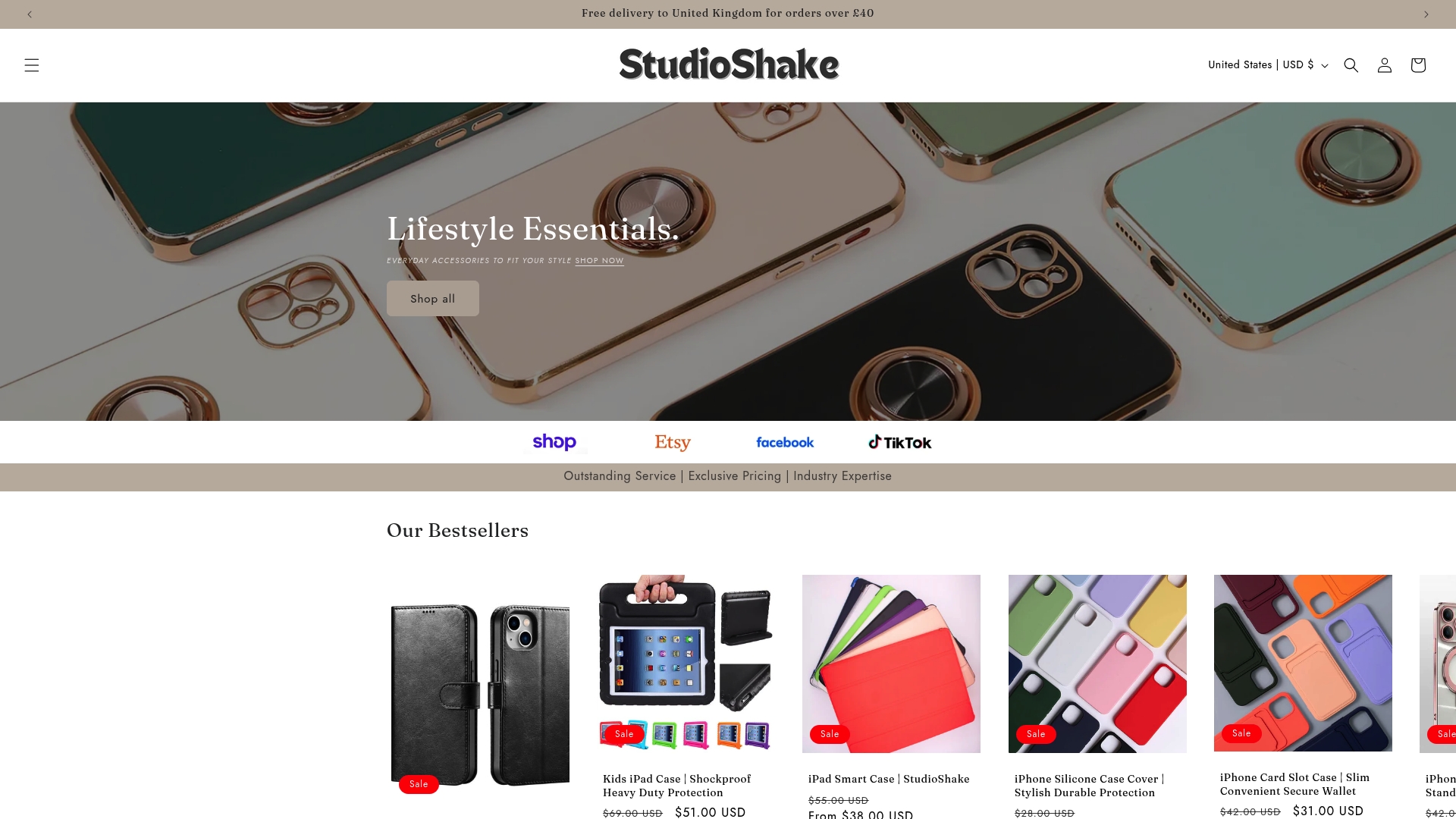
How to Select Durable Phone Cases for Long-Lasting Protection
Share
Did you know that over 70 percent of smartphone users have experienced accidental drops that caused device damage? Your choice of phone case plays a bigger role in device safety than most people realize. Whether you juggle calls on busy commutes, work outdoors, or share your phone with curious kids, the right case can mean the difference between a costly repair and peace of mind. Discover practical steps to find protective features that truly match your daily routine.
Table of Contents
- Step 1: Assess Your Daily Phone Usage Needs
- Step 2: Identify Essential Protective Features
- Step 3: Compare Material Durability And Construction
- Step 4: Check Fit And Compatibility With Your Device
- Step 5: Verify Quality Through Customer Reviews
Quick Summary
| Key Point | Explanation |
|---|---|
| 1. Assess your phone usage needs | Examine your daily activities to determine the phone case durability required for your lifestyle. |
| 2. Identify essential protective features | Look for cases with shock absorption, raised edges, and reinforced corners for better protection. |
| 3. Compare material durability | Evaluate materials like silicone, polycarbonate, and TPU to ensure reliable protection tailored to your usage. |
| 4. Check fit and compatibility | Ensure your case is designed for your specific phone model to maintain functionality and protection. |
| 5. Verify quality through reviews | Read customer feedback to assess real-world performance and ensure the case meets your needs. |
Step 1: Assess your daily phone usage needs
Some phone cases offer better protection than others depending on your individual lifestyle and daily interactions with your device. According to the UK Home Office mobile device security guide, understanding your personal usage patterns is critical for selecting appropriate protective measures.
Start by examining how and where you typically use your phone. Are you constantly on the move? Do you work in construction or outdoor environments? Do you have children or pets who might accidentally knock your device? Each scenario demands a different level of phone case durability.
Consider documenting your phone usage across different environments. Track moments like:
- Commuting on public transport
- Working in potentially rough workplace settings
- Outdoor recreational activities
- Home usage around children or active household members
Think about potential physical risks your phone encounters. A desk worker might need minimal protection compared to a tradesperson who requires robust shock absorption.
 As research from the Office for Health Improvement and Disparities suggests, understanding user interaction helps inform appropriate protective strategies.
As research from the Office for Health Improvement and Disparities suggests, understanding user interaction helps inform appropriate protective strategies.
Pro Tip: Take photographs or make notes about situations where your current phone case fails to provide adequate protection.
By meticulously assessing your daily phone usage, you will make a more informed decision about selecting a durable phone case that matches your specific lifestyle needs.
Step 2: Identify essential protective features
Selecting the right protective features for your phone case requires understanding key safety elements that shield your device from potential damage. According to the UK Home Office mobile device security guide, robust casing and comprehensive protection mechanisms are critical for maintaining device integrity.
Look for phone cases that offer multiple layers of protection. The ideal case should include:
- Shock absorption capabilities
- Raised edges to protect screen from direct impact
- Reinforced corner protection
- Materials that resist scratching and wearing
Research from the Office for Health Improvement and Disparities highlights the importance of understanding user interaction with digital devices. This means considering how different protective features might impact your daily phone usage.
Pay special attention to material composition. Silicone and rubber provide excellent shock absorption, while hard polycarbonate shells offer superior scratch resistance. Hybrid cases combining multiple materials often deliver the best overall protection.
Pro Tip: Test the case’s grip and comfort in your hand before purchasing. A protective case should not compromise your ability to use the phone comfortably.
By carefully evaluating these essential protective features, you will ensure your phone remains safe in various environments and scenarios.
Step 3: Compare material durability and construction
Understanding the intricate details of phone case materials is crucial for selecting a truly protective accessory. According to the UK Home Office mobile device security guide, evaluating the durability of materials is fundamental to ensuring long term device protection.
Different materials offer unique protective qualities. Polycarbonate provides rigid protection against impacts, while silicone offers flexible shock absorption. Thermoplastic polyurethane (TPU) combines elements of both materials creating a balanced defensive approach.
Here’s a comparison of common phone case materials and their protective qualities:
| Material | Shock Absorption | Scratch Resistance | Grip Comfort |
|---|---|---|---|
| Silicone/Rubber | Excellent | Moderate | High |
| Polycarbonate | Good | Excellent | Moderate |
| Thermoplastic Polyurethane (TPU) | Very Good | Good | High |
| Hybrid (Multiple Materials) | Excellent | Excellent | High |
When comparing construction quality, assess these key characteristics:
- Thickness of material walls
- Seamless edges and precise manufacturing
- Reinforcement around vulnerable areas like corners
- Quality of material bonding and connection points
Research from the Office for Health Improvement and Disparities emphasizes the importance of understanding how material composition impacts device performance across various environments.
Consider performing a simple durability test. Gently press and twist the case to check for structural integrity. A quality case should maintain its shape without excessive flexibility or rigidity.
Pro Tip: Look for cases with military grade certification which indicates they have passed standardized durability testing.
By carefully examining material composition and construction details, you can select a phone case that provides reliable protection tailored to your specific usage patterns.
Step 4: Check fit and compatibility with your device
Ensuring your phone case fits perfectly is more than just a matter of aesthetics. According to the UK Home Office mobile device security guide, selecting accessories that are precisely compatible with your device is crucial for maintaining optimal protection.
Begin by verifying the exact model of your smartphone. Different phone generations and manufacturers have unique dimensions that require specific case designs. Even slight variations can impact the case’s protective capabilities and overall functionality.
Consider these critical compatibility factors:
- Precise model number
- Exact device dimensions
- Camera and port placement
- Button and speaker cutout alignments
Research from the Office for Health Improvement and Disparities emphasizes the importance of seamless device integration. A well fitted case should feel like a natural extension of your smartphone.
Physical testing is essential. Attempt to:
- Confirm buttons remain fully accessible
- Verify wireless charging compatibility
- Check that screen protector aligns correctly
- Ensure no obstruction of microphone or speaker functions
Pro Tip: If purchasing online, carefully review product specifications and user images showing precise device fitting.
By meticulously checking compatibility and fit, you protect your device while maintaining its full functionality.
Step 5: Verify quality through customer reviews
Customer reviews offer an invaluable window into real world phone case performance and durability. According to the UK Home Office mobile device security guide, consulting customer ratings and experiences is a critical step in assessing product reliability before making a purchase.
When examining reviews, look beyond star ratings and dive into detailed user experiences. Authentic feedback provides insights that marketing materials cannot capture. Pay special attention to reviews from individuals with similar lifestyle and usage patterns to your own.
Focus on reviewing comments that discuss:
- Long term durability
- Protection during accidental drops
- Comfort and grip
- Compatibility with wireless charging
- Ease of installation
Research from the Office for Health Improvement and Disparities highlights the importance of comprehensive user feedback in understanding product effectiveness.
Be strategic in your review analysis. Look for patterns in feedback rather than isolated comments. Multiple users mentioning similar strengths or weaknesses provide more reliable information than single extreme experiences.
Pro Tip: Check reviews across multiple platforms to get a balanced perspective and avoid potential bias from a single source.
By carefully investigating customer reviews, you gain practical insights that help you make an informed decision about your phone case purchase.
Find the Perfect Durable Phone Case for Your Lifestyle
Choosing a phone case that truly protects your device from daily wear and accidental drops can feel overwhelming. This article highlights the importance of considering your unique usage patterns, essential protective features like shock absorption and reinforced corners, and material durability. If you have struggled to find a phone case that fits perfectly while keeping your device safe, you are not alone. It is vital to select a case that balances comfort, durability and seamless compatibility with your phone.
Explore our carefully curated iPhone collection for a range of durable phone cases engineered to meet diverse protection needs. Whether you want a case that offers excellent grip or one that is compatible with MagSafe accessories, StudioShake provides quality options designed to last.

Don’t wait until your phone shows signs of damage. Protect your device today by browsing StudioShake’s full range of protective phone cases and mobile accessories. Visit StudioShake and choose a case crafted for long-lasting defence that fits your lifestyle perfectly.
Frequently Asked Questions
How can I assess my daily phone usage needs for selecting a durable phone case?
Start by examining your daily routines and environments where you use your phone. Document situations like commuting, outdoor activities, or usage around children, as these will help you determine the level of protection needed for your device.
What essential protective features should I look for in a durable phone case?
Look for features such as shock absorption capabilities, raised edges to protect the screen, and reinforced corners. A case with multiple layers of protection will ensure your phone is better shielded against impacts and accidents.
How do I compare material durability when choosing a phone case?
Evaluate the most common materials: silicone for shock absorption, polycarbonate for scratch resistance, and hybrid cases for a balance of both. Perform a simple durability test by pressing and twisting the case to assess its structural integrity before purchasing.
What factors should I check for fit and compatibility when selecting a phone case?
Ensure the phone case fits your specific smartphone model by verifying the model number and dimensions. Check the alignment of buttons, camera placement, and whether it allows for wireless charging compatibility, as a proper fit maintains functionality while providing protection.
How can I verify the quality of a phone case through customer reviews?
Examine detailed customer reviews that discuss long-term durability and real-world performance of the phone case. Look for consistent feedback about protection during drops and overall comfort to gain better insights before making a decision.
What should I do if I find conflicting reviews about a phone case?
Analyze the reviews for patterns rather than isolated comments, as multiple users highlighting the same benefits or issues can provide a clearer picture of the product’s reliability. Focus on experiences that relate closely to your own usage habits for the most relevant insights.
